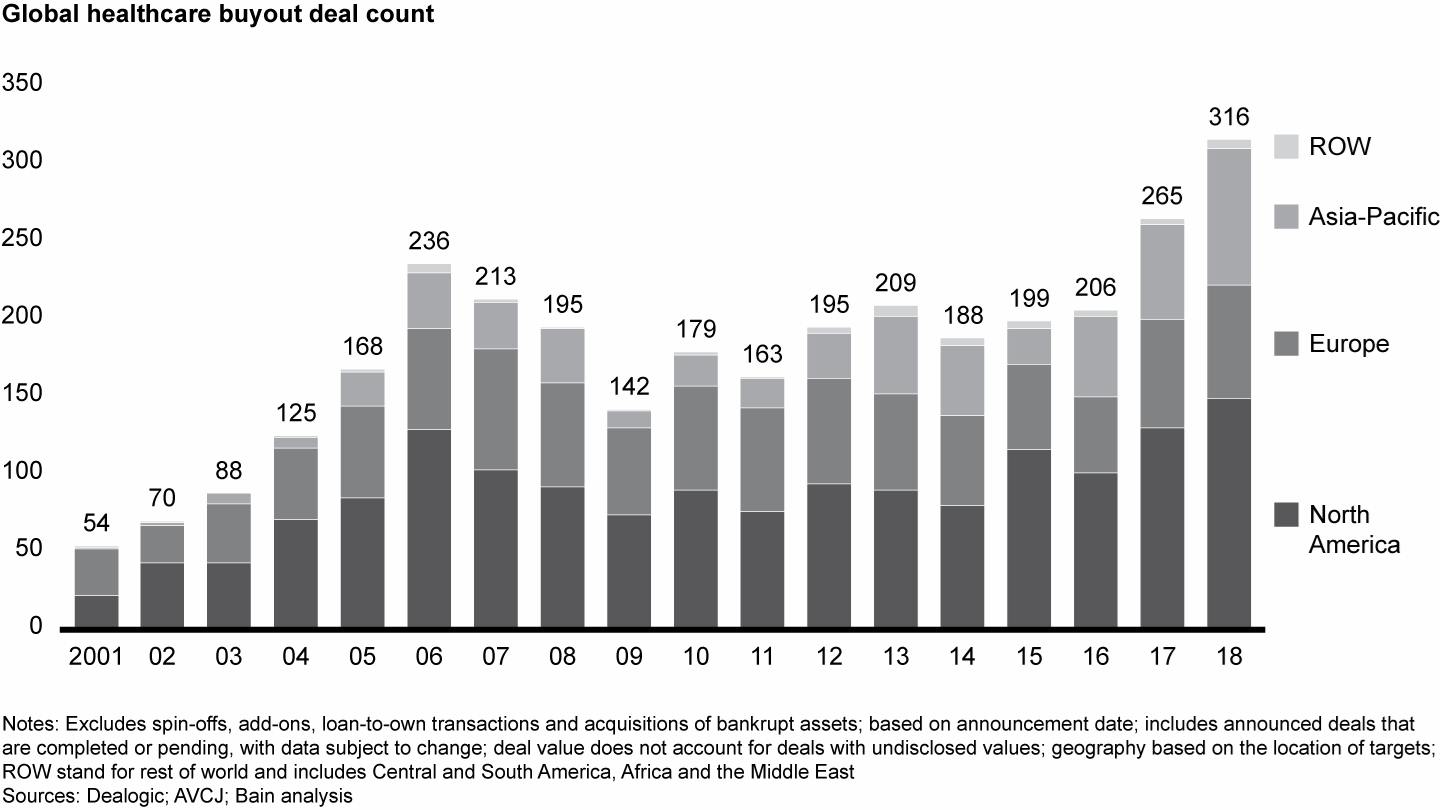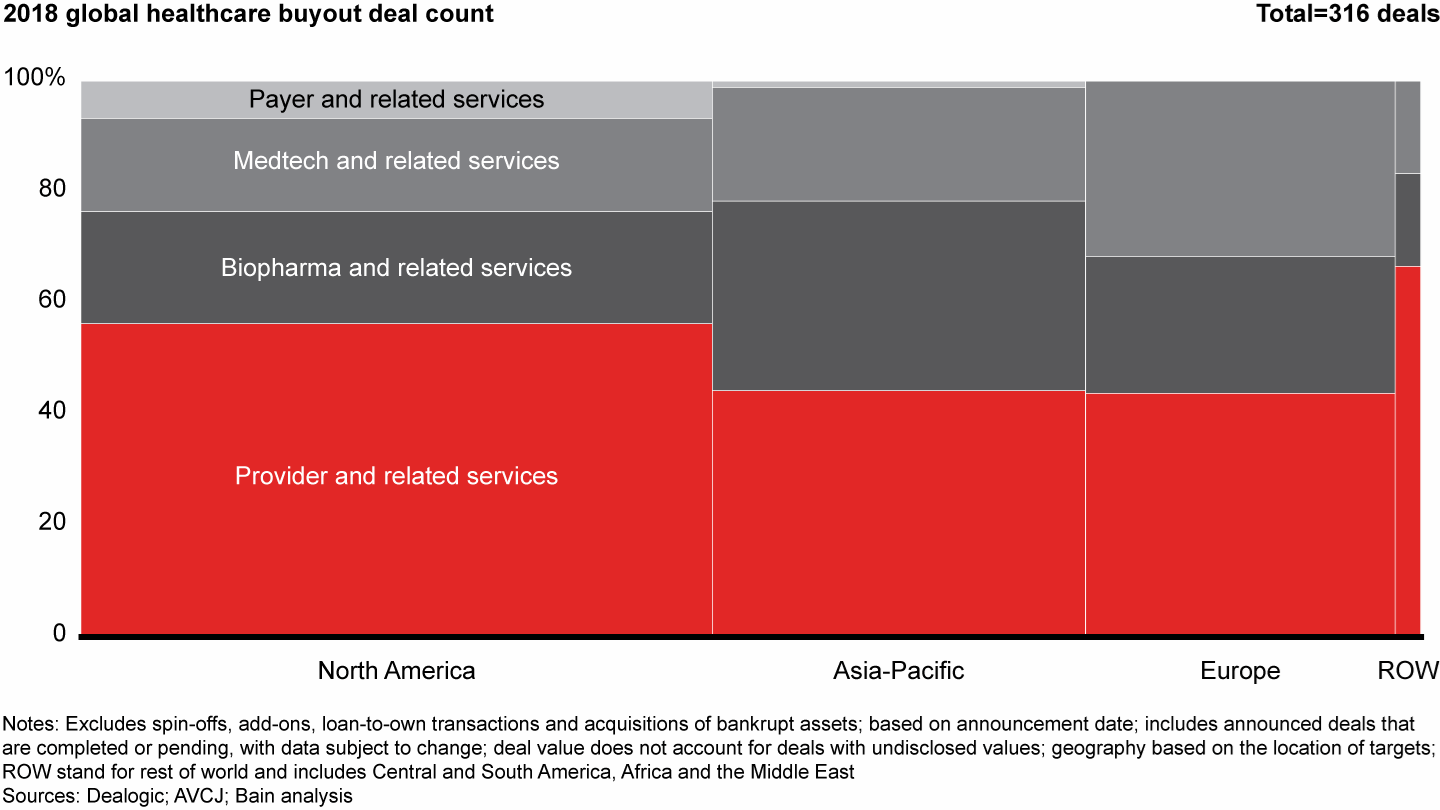Report

Executive Summary
- 2018 was the most active year yet for the Asia-Pacific region, as deal value increased to $15.8 billion across 88 deals, up from $7.2 billion across 61 deals the prior year.
- China, Australia and India represented 83% of deal volume in Asia, with 44, 15 and 14 deals, respectively. Provider had the most activity, with 39 deals, of which roughly 75% came from China, Australia and India.
- Competition further intensified, and deal sizes rose, spurring more consortium and partnership strategies.
- Cross-border investment from Chinese funds continues as they look to gain access to category-leading platform assets and bring expertise from around the world home to address the huge unmet demand for healthcare in China.
This article is part of Bain’s 2019 Global Healthcare Private Equity and Corporate M&A Report. Explore the contents of the report here or download the PDF to read the full report.
-
Click to Expand: Regional Overview
Global healthcare PE activity set another record in 2018, with 316 announced deals valued at $63.1 billion—a marked increase over $42.6 billion across 265 deals in 2017. Activity and disclosed value rose in every region, an increase that was especially pronounced in Asia-Pacific, where the volume of announced deals grew by 44%.
The rise in values stemmed primarily from more large buyouts, as eight deals in 2018 were valued at greater than $2 billion each vs. just four in 2017. Across regions, the provider sector again was the most active, accounting for more than half of total deal activity and disclosed value. Biopharma posted the second-largest share, accounting for roughly one-quarter of volume and value globally.
Similar to prior years, the countries outside North America, Europe and the Asia-Pacific region saw minimal healthcare PE deal activity in 2018. There were six buyouts, two more than 2017, with no deal values disclosed. Of those six buyouts, four occurred in the provider sector, and three of those had Brazilian targets. This was a departure from 2016 and 2017 activity, which each saw just one deal in the provider sector and one Brazilian target.
In the Asia-Pacific region, deal volume surged from 61 in 2017 to 88 in 2018, while disclosed value more than doubled from $7.2 billion to $15.8 billion. Provider activity, which accounted for about 45% of volume in the region and about 55% of disclosed value, mainly spurred this increase as investors anticipate increased healthcare consumption across China and India. The region also saw arguably the widest spectrum of deal types from PE funds, ranging from a number of seed funding–style investments to take-privates of large public entities, such as Sirtex, which was purchased for $1.4 billion in a partnership between China-based fund CDH Investments and China Grand Pharmaceutical and Healthcare Holdings (see Figures 5 and 6).
North America and Asia-Pacific saw increased deal activity, while Europe was relatively flat


The provider sector was the most active across all geographies


Rising incomes and aging populations in Asia’s largest markets, China and India, have significantly strengthened demand for access to healthcare, in turn driving demand for healthcare deals. As a result, 2018 was another banner year for healthcare buyout activity in the Asia-Pacific region. Investors made 88 deals, with a total disclosed value of $15.8 billion, up sharply from the 61 deals worth $7.2 billion in 2017.
The region’s deal increase accounted for more than half of the total global rise in buyout volume. Heightened activity in China, which had only 8 deals in 2016, 32 in 2017 and finally 44 in 2018, accounted for most of the surge in volume. Australian activity also rose meaningfully to 15 deals in 2018 from 6 deals in 2017.
China and India’s consumer demand fueled the provider sector in particular. Provider-related deals rose to 39, up from 23 deals in 2017, and accounted for 44% of regional volume and 53% of regional value in 2018. Hospital deals were the most common in this segment as China expands provider coverage. Three of the top five deals in the region were provider related, including the region’s largest of the year, Brookfield Business Partners’ acquisition of Australian hospital provider Healthscope for $4.1 billion.
As China continues to address the growing healthcare needs of a large, aging population and a likely upcoming surge of chronic diseases, it will increasingly look to supplement its local innovation engine with global expertise. In recent years, China’s investors have broadened their focus to global provider and medtech assets. For example, in a hotly contested deal, CDH Investments and China Grand Pharmaceutical and Healthcare Holdings acquired Sirtex Medical, a developer of small-particle technology used in oncology treatments, for $1.4 billion. The partners intend to support growth in Sirtex’s core markets and accelerate growth in the Chinese market.
Many large, global funds have bought into the Asia-Pacific growth story through dedicated local arms. Some of the world’s largest buyout firms are closing record-setting Asian funds after a dip in the early 2010s; KKR’s Asia Fund III closed $9.3 billion of funding in mid-2017, the largest fund in the region. More than one-quarter of Asia-Pacific deals during the year involved US- or Europe-domiciled acquirers that see great opportunities in a fast-growing healthcare economy. This was a key driver in London-domiciled Permira’s purchase of I-Med, an Australian diagnostic imaging company, for $1 billion, and Bain Capital’s acquisition of DSM Sinochem, now known as Centrient, a manufacturer of active pharmaceutical ingredients and finished drug products, through its Asia-focused fund for $690 million.
Stiff competition among both corporates and buyout funds has prompted many investors to consider creative or alternative deal structures and strategies for the region. Funds have been teaming together to acquire larger assets; three of the top five deals during the year involved a consortium or corporate partnering, including the $1 billion acquisition of Indian health insurer Star Health and Allied Insurance by a consortium composed of WestBridge Capital and Madison Capital Partners. Investors also continued to seek public-to-private transactions, including the take-private of iKang Healthcare Group by Chinese fund Yunfeng Capital and Alibaba Group Holding Limited for $1.2 billion. This deal represented one of the last of the US-listed major Chinese assets to be taken private, with the likely goal to list in Asia, where valuation multiples for healthcare assets continue to be higher than in the US.
Investors across the region also deployed buy-and-build platform strategies that have been common in North America and Europe for years. In Southeast Asia, TPG acquired a portfolio of 39 pathology laboratories from Healthscope for $207 million and then announced intentions to add on Innovative Diagnostics, with further intentions to continue growing the footprint. And in India, KKR invested in Max Healthcare through its portfolio company Radiant Life Care to create one of the largest hospital networks in northern India.
Stabilizing regulatory changes in China washed through the biopharma and medtech sectors, spurring an increase in growth-stage assets. The Made in China and Healthy China 2030 initiatives, along with a restructuring of the distribution systems for drugs and devices, have encouraged more pharma and medtech innovation in the country. Indeed, roughly one-third of the 30 Asia-Pacific biopharma deals are early-stage investments from PE funds. For example, the Ireland Strategic Investment Fund led a Series C funding round totaling $200 million in WuXi NextCode, a genomic information company. Existing backers Temasek Holdings, Yunfeng Capital and Sequoia Capital also reinvested. Funds invested in established biopharma companies as well; a consortium composed of ChrysCapital, GIC and Canada Pension Plan Investment Board invested $350 million for a roughly 10% stake in Mankind Pharmaceuticals, which derives a large majority of its revenue from OTC drugs as India’s fifth-largest drugmaker.
Meanwhile, the first substantial wave of healthcare buyouts in Asia-Pacific are reaching the end of their holding periods, leading to several high-profile sponsor-to-sponsor exits. WestBridge Capital and Madison Capital Partners acquired Star Health and Allied Insurance from a consortium of PE investors for $1 billion, one of the top 10 global exits by value in 2018.
In another high-profile exit, Navis Capital purchased Australia’s largest independent provider of medical technology, Device Technologies, from Pemba Capital Partners for $509 million. As more healthcare assets come of age and funds realize solid returns, we expect sponsor-to-sponsor activity in the region to stay at a high level.
Early in 2019, the major trends of 2018 show no signs of abating despite concerns that economic growth in China is slowing. Healthcare private equity tends to be less vulnerable to downturns than other sectors, so we expect demand for assets in Asia-Pacific to increase over the coming years. Buyout funds will invest more in growth-stage assets such as Chinese pharma. And as companies explore ways to increase access to healthcare, emerging trends, such as digital healthcare solutions, should gain steam in China, India and other countries. Those trends are fueling interest in companies such as Good Doctor, Wedoctor and Alodokter.
Investors will continue to seek deals in the provider and medtech sectors, and explore creative ways to deploy capital, such as public-to-private takeovers. Companies such as Australian primary care giant Healius, which rejected a takeover attempt from its largest shareholder, Jangho Group, in January 2019, will likely continue to attract interest from investors across the region and beyond.